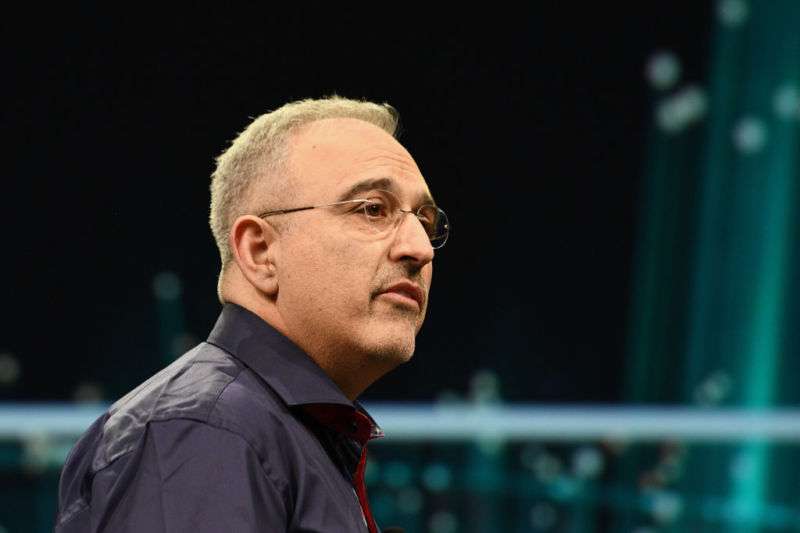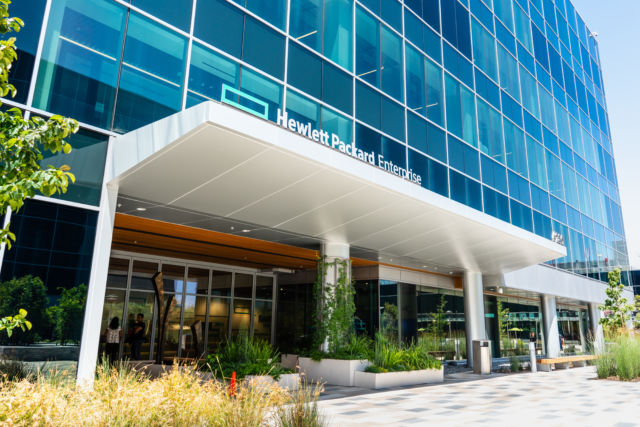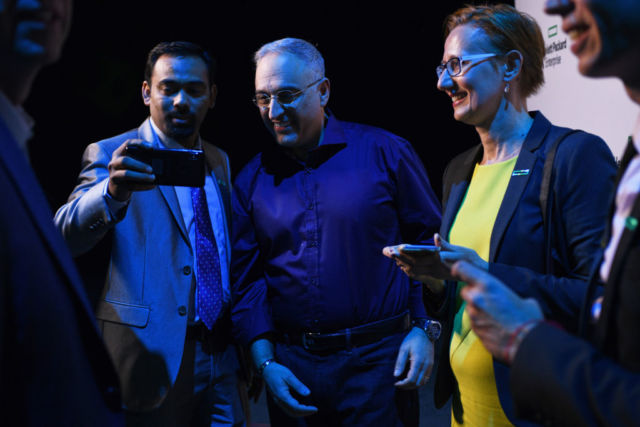
Antonio Neri and Hewlett Packard Enterprise’s cultural revolution

It’s been just over two years since Antonio Neri was named President of Hewlett Packard Enterprise (HPE), the infrastructure-oriented company that emerged from the 2015 breakup of the legendary but slightly road-worn tech giant Hewlett Packard.
Since then, Neri has led something of a cultural transformation—along with an acquisition binge that has pulled 14 companies, including Aruba Networks and the supercomputer maker Cray, under the HPE umbrella. And at last month’s HPE Discover conference in Las Vegas, Neri announced the next big shift for the company: moving everything that HPE does to an “as-a-service” model. While storage, computing, networking, and everything else HPE does will still be available for the foreseeable future under the current, traditional business model, those offerings will also be made available on a pay-for-what-you-use plan. That way, customers can (within reason) expand and contract their IT infrastructure capacity on demand.
Ars happened to be in Vegas for our annual security conference pilgrimage to Black Hat and DEFCON, and Neri graciously agreed to meet up an interview. The newish company president discussed his admiration for another high profile tech executive, how he’s seen HPE transform since taking the helm, and what it will take to get customers to buy into the company’s new as-a-service ethos.
Strategically starting over
A veteran of HP who started as a customer service engineer at the company in 1995, Neri understands what “culture” means. He inherited HPE after the shedding of the former electronic-data systems (EDS) services unit (which was sold to CSC for $8.5 billion to create DXC Technology in 2016) and the “spin-merge” divestment of much of HP’s software business to Micro Focus.
Neri said that he has looked to Microsoft’s Satya Nadella as a role model, “because he had to do the same thing“—pivoting a whole company toward cloud services. “He said, ‘Our strategy is cloud, and everything we do will be to align behind Azure,’ pretty much. He understood that other parts are important, but he said, ‘Everything’s north star will be Azure.’ Here it’s the same thing. Everything we do will be to deliver everything as a service.”
Neri and HPE may actually have two North Stars. At the center of the company’s current strategy are two sets of platforms. The first is HPE’s Greenlake—an infrastructure management service for both cloud and on-premises that turns even local infrastructure into a “consumption-based” resource that can be scaled up and down (within limits) on demand.
The second central tenant is HPE’s pair of analytics and machine-learning based automation tools: InfoSight and OneView. Combined, these two sets of technologies will tie into HPE’s new Primera storage platform, Aruba networking hardware, and even supercomputing resources such as Silicon Graphics (and, if the transaction completes, Cray) systems to create an “as-a-service” fabric. With these two tentpoles, Neri’s long-term goal for the company is what he calls “cloudless” computing—a unified “as-a-service” management of all compute, storage, and network resources transparently across all public and private clouds and “edge” devices.
At least, that’s the plan. Neri says he believes that HPE will be able to deliver on it within three years. But execution of this plan depends on HPE’s ability to pivot from the previous model that has made it a (mostly) viable company. That’s not going to happen without breaking some eggs—and getting HPE’s ecosystem of resellers and partners to come along for the ride.
Next, please
It is hard for anyone with any longevity in IT to not have some sort of emotional response to everything that’s happened to the company Bill Hewlett and David Packard launched from a legendary one-car Palo Alto garage in 1938. (Full disclosure: I still suffer from nostalgia for the HP 3000, the IMAGE database, and Apollo workstations.) Back in 2011, I wrote with some angst about the state of HP after Meg Whitman took over the company from the somewhat misguided leadership of Leo Apotheker. And after weathering that particularly nasty storm, Whitman appeared to follow the advice Ars (and many others) suggested, just not in the way many had anticipated. She succeeded by splitting HP into consumer (HP Inc.) and enterprise (HPE) units, jettisoning much of what a decade’s worth of CEOs had added onto the company. The goal was simple: refocus.
The streamlining strategy for HPE, presented by Whitman in 2017 as “HPE Next,” hinged on a total overhaul of HPE’s business practices and culture. Now just over 18 months into his tenure, Neri is pushing that strategy toward its final execution—a “transformation of processes, transformation of people, and transformation of IT,” as he calls it.
On the IT side of the company, that has meant a significant overhaul of HPE’s internal systems—something that hadn’t been done in decades. Much of the company’s internal operations have gone unaltered since Carly Fiorina was CEO back in the early 2000s.
“Since the Compaq merger of 2000, there hadn’t been a major transformation of processes and procedures in IT,” Neri told Ars. So recently, the company has dramatically reduced the number of applications in use. “We used to have 6,000 apps and we went to 3,000 apps to run the company. Now we are 1,000 apps, and eventually we are going to go down to 400 apps.” Neri said the number of data centers operated by HPE has also shrunk—from 82 down to two.
But even as IT was pared down, there hadn’t been a real re-thinking of the IT architecture within HPE ’til now. “The problem is we never transformed, because we had to complete the mergers—[former HP CEO] Mark [Hurd] bought EDS, then we had a little bit of drama with Autonomy, then we went through the split, and then we went to the spin-off.”
Neri has has been through all of that, and he intimately knew all of the systems within the company. “So I knew that for us to be way more agile and react faster to the market dynamics, we’ve got to fix that foundation,” he said. “Whether it’s the master data, whether it’s ERP systems, or whether it’s E-commerce platform, we take it for granted but that’s where the action is.”
The people part
In the last decade, HPE has also radically changed in terms of its number of employees. Before her departure in 2017, Whitman announced about 5,000 employees would be laid off. More employees were shed in spinoffs. But after this latest acquisition binge, HPE’s head count back has risen back over 60,000 employees.
With that new workforce, the shift in the company’s strategy is simultaneously driving a major cultural transformation. “I will argue that the technology piece of the digital transformation is not the hardest part,” Neri told Ars. “It’s the people and the processes that are the hardest part, and how you digest [all the technology]. It’s one thing to sell a networking switch with a bunch of ports and another to sell connectivity for the right use case.”
The cultural shift Neri is overseeing is reflected by HPE’s new headquarters. The campus in San Jose has been designed to “provide a workplace experience for the modern way we work,” Neri said. “It’s a state of the art digital workplace where people actually feel proud to come and work. And the whole experience is the amenities. Everything you provide makes that place special because it actually incentivizes creativity, incentivizes people to come to work instead of working from home, and at the same time [incentivizes] collaboration and so forth.”
Along with the new physical space, Neri says HPE has had to reshape the company’s relationship with its employees, specifically “what experiences we provide to them, what benefits we provide to them, and what is their career growth opportunity.” He wants HPE employees to have chances to stay and develop “like what I had from the call center in 1995 to becoming the present CEO. We are spending a lot of energy to make that transition happen for our people.”
Still, Neri acknowledges that not everyone is going to make it through the transition. “I mean that’s the reality—some people will not make it, because that’s the world,” he said. Shifting to “as a service” will require transformations in how people design and sell products.
“It is not like the compute guys, who had a deep rooted culture from the Compaq days, are not important, but they understand they are serving a different mission,” he explained. “And the mission is to develop the best secure compute platform that can be consumed as a service. And therefore, when you think about value propositions and roadmaps, you got to have that as the core principle. Everything else follows. And that’s where it is a change in management and it is a culture shift and also a people transition—not everybody can make that pivot.”
Focusing on delivering compute hardware as a service, Neri said, requires a bit of a mindset change. When designing servers, for instance, Neri believes engineers “think about density, they think about faster, cheaper, better. They think about, obviously, security,” he said. “But now I need to think about how I make sure that compute delivers outcomes faster through as a service model, and everything else has to align around that. The same goes on the storage side. It’s not about the storage platform, it’s about data management and how you consume it as a service.”
To move the engineering processes in the right direction, Neri has been working through roadmap reviews for each product line. “We have a saying—’You don’t get what you expect, but you get what you inspect.’ And that’s the fundamental question here as I go through the roadmaps. ‘Is this notion of as-a-service holding true? If it’s not, what changes do we need to make in the organization? In some cases, those changes mean changing people, as brutal as that is. But that’s the reality.”
Mining innovation
Neri said that these transformational efforts so far have paid off financially. Earnings per share are up 63% in the last year (if you don’t count some charges related to tax changes and discontinued businesses). “Our operating profit grew 26%, our revenue grew 6% when you extract the commoditization side that we decided not to play in,” Neri said. “I [also] feel very strong about our innovation.”
That innovation not only includes what HPE has done to advance its major compute and storage businesses, it also includes the “inorganic” innovation that has come from the 14 acquisitions Neri has overseen. In addition to the financial aspect, Neri said he has monitored each acquisition from the standpoint of “how we accelerate our strategy from a talent and intellectual property perspective—do they have the IP that I don’t have that will accelerate my strategy? I’m able to acquire new talents with new skillsets or specialized skillsets, which are hard to get.”
Those acquisitions have been focused on turning the company toward the “as-a-service” model and HPE’s increased focus on edge computing—cloud-connected systems in industrial and enterprise applications that require significant local processing power. Aruba was acquired for its software-defined networking, and it soon became the core of HPE’s networking operations (with HPE’s existing products being rolled into it). SimpliVity was acquired for its “hyperconvergence” platform as HPE pursued hybrid cloud capabilities. Cloud Cruiser, the services metering company, became “the core brain for HP metering capabilities,” Neri explained. “Nimble Storage, Cray, SGI [the former Silicon Graphics], Niara, Cape Networks, Blue Data Storage, Quattro Labs, they’re all integrated there.”
In most cases, the technical integration of new acquisitions has not been the greatest obstacle in Neri’s view. “The biggest challenge in those integrations is how you bring in a board and preserve the good aspects of their culture,” Neri said. In Aruba’s case, Neri said it was a “reverse integration,” since much of the company’s networking capabilities had been spun off into the H3C joint venture in China. In other cases, such as SGI, the integration was easy, because “people came from the same place—deep, deep system engineering, complex environments,” Neri explained. “Same people, same culture.”
With the acquisition of the storage company Nimble, the integration was more complex, as HPE worked out how to “cross-pollinate capabilities,” Neri said. “On one side we have mission critical capabilities, on the other we have intelligence capability.” Specifically, the merger of those two created HPE’s Primera, the company’s new storage offering—which, again, is engineered to work with HPE’s “everything-as-a-service” model.
Greasing the skids with cash
Getting customers to come along for the ride will take more than just a cloud console and a repeated as-a-service mantra. It’s going to take a significant financial upside for customers to move many off their existing IT approaches. That’s why Neri believes that some of HPE’s most important strategic assets are being delivered by HPE’s Financial Services unit and the “recapture” of cash from existing IT infrastructure.
First, “you can do asset life cycle management to free up money to reinvest the modernization and potentially shift to a consumption model,” Neri explained. “And second is the underpinning of the financing for the consumption model.”
In other words, Neri’s pitch for the service model is that customers can essentially finance their shift to a services-based model and save more long-term by paying only for what they use (with a certain amount of commitment to a maximum and minimum, to be clear). By remarketing customers’ old hardware to markets where older systems remain viable, Neri claimed HPE had “recaptured $330 million for customers [last year]. In fact, one customer recaptured $90 million of that. And by the way, it was multi-vendor hardware—it’s not just HPE.”
Today, HPE’s Financial Services unit can “see where [the hardware] is in the depreciation [schedule],” Neri explained. “We have a very efficient machine to put those assets back to work. And that business runs beautifully and also sustainably, because when you look at that business it’s $30 billion under asset management, and the impairment or the loss on that business is only 50 basis points. You’re talking about 0.5% loss on $13 billion. So it generates a ton of profit on one end and a return on equity for shareholders because of cash utilization, but it’s also strategic to make this pivot.”
It will take more than a perceived financial upside for HPE’s strategy to work, of course. This kind of philosophical change will only succeed if customers feel comfortable handing over the security, availability, and scalability of their operations to a company that very recently seemed to have exited from the services business entirely. And given that HPE’s competitors, such as Dell and IBM, are focusing on delivering fairly similar visions, it’s going to be a tough fight.
Neri also has to convince HPE’s many resellers to get onboard as well, pushing them to become “solution providers” around services rather than selling physical hardware. That may be the biggest challenge Neri currently faces. Though judging by the audience size at Discover, resellers may have already seen the writing on the wall. In recent years, it’s been a cultural shift for everyone, after all.






